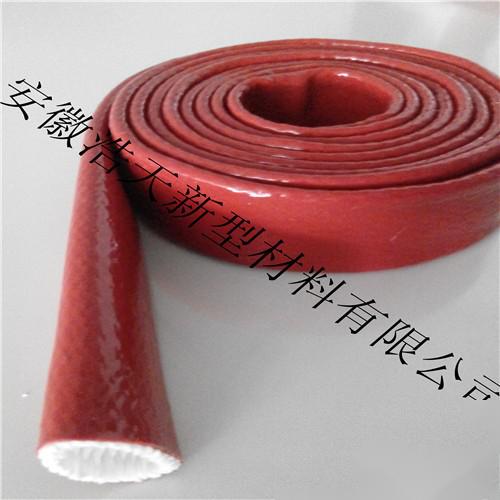Haotian Brand High Temperature Sleeves Features and Applications
1. Safe and environmentally friendly, protecting workers' health
Alkali-free glass fiber has excellent tensile strength, does not wrinkle or break, is resistant to vulcanization, emits no smoke, contains no halogens, is non-toxic, is pure oxygen non-flammable, and has good insulation properties. After curing with silicone, its safety and environmental protection properties are further enhanced, effectively protecting workers' health and reducing the incidence of occupational diseases. Unlike products made from asbestos, which pose significant risks to human health and the environment.
2. Excellent high-temperature resistance
The surface of the high-temperature sleeve contains both 'organic groups' and 'inorganic structures' in its silicone composition. This unique composition and molecular structure combine the properties of organic materials with the functionalities of inorganic materials. Compared to other polymer materials, its standout feature is its high-temperature resistance. With a silicon-oxygen (Si-O) bond as the main chain structure, the bond energy of C-C bonds is 82.6 kcal/mol, while the bond energy of Si-O bonds in silicone is 121 kcal/mol. Therefore, it has high thermal stability, and the chemical bonds of the molecules do not break or decompose under high temperatures (or radiation). Silicone not only withstands high temperatures but also low temperatures, allowing it to be used over a wide temperature range. Both its chemical and physical mechanical properties change minimally with temperature variations.
3. Splash protection, multiple layers of security
In the smelting industry, the medium temperature inside electric furnaces is extremely high, making it prone to high-temperature splashes (the same goes for the welding industry). After cooling and solidifying, it forms slag on pipes or cables, causing the rubber outer layer of the pipes or cables to harden and eventually become brittle and crack. This can damage unprotected equipment and cables. The high-temperature sleeves, coated with multiple layers of silicone, provide multiple layers of safety protection, with high-temperature resistance reaching up to 1300 degrees Celsius, effectively blocking splashes of molten iron, copper, aluminum, and other high-temperature molten materials, preventing damage to surrounding cables and equipment.
4. Insulation, energy conservation, radiation resistance
In high-temperature workshops, many pipes, valves, or equipment have very high internal temperatures. If protective materials are not used, it can easily lead to personnel burns or heat loss. Haotian high-temperature sleeves have better thermal stability than other polymer materials, as well as radiation resistance and insulation properties, preventing accidents, reducing energy consumption, and preventing the heat of the medium inside the pipes from being directly transferred to the surrounding environment, thus preventing excessive workshop temperatures and saving cooling costs.
5. Moisture-proof, oil-proof, weather aging resistance, pollution resistance, prolonging equipment lifespan
High-temperature sleeves possess strong chemical stability, with organic silicone showing no reaction to oils, water, acids, or alkalis. They can be used long-term without aging at temperatures below 260℃, with a lifespan of several decades in natural environments. They effectively protect pipes, cables, and equipment in such contexts, greatly extending their service life.
6. Ozone resistance, voltage resistance, electric arc resistance, and corona resistance
Due to the surface coating of silicone, whose main chain is -Si-O-, it is not easily decomposed by ultraviolet light and ozone. High-temperature sleeves have excellent electrical insulation properties, with dielectric loss, voltage resistance, electric arc resistance, corona resistance, volume resistivity, and surface resistivity all ranking among the best in insulating materials. Moreover, their electrical performance is minimally affected by temperature and frequency. Therefore, they are a stable electrical insulating material widely used in the electronics and electrical industries.
7. Flame retardant, reducing fire occurrence and spread rate
If the medium transported in the pipes is flammable or toxic, leaks can easily lead to fires or casualties; cables can also catch fire due to localized high temperatures. The high-temperature sleeves are made from extremely heat-resistant woven glass fiber, and the silicone surface is infused with appropriate flame retardants and other special materials, giving them excellent flame retardancy. Even in the event of a fire, they can prevent the spread of flames and protect the integrity of internal pipelines for an extended period, providing ample time for the recovery of data and important information.













